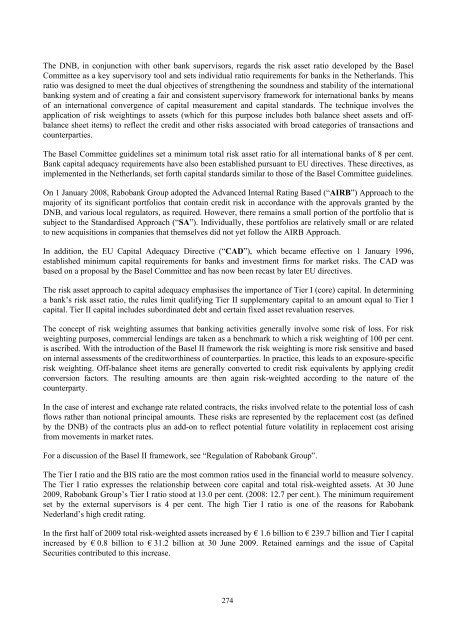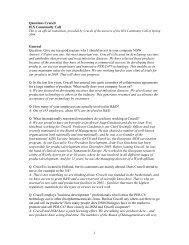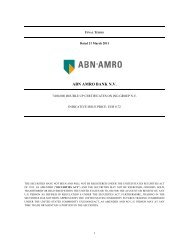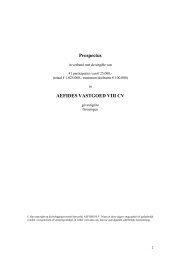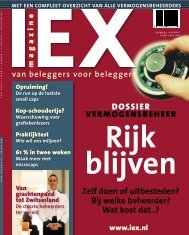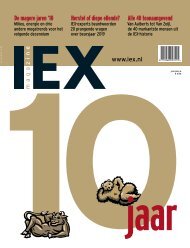Dit prospectus is gemaakt voor de uitgifte van dit product en ... - Iex
Dit prospectus is gemaakt voor de uitgifte van dit product en ... - Iex
Dit prospectus is gemaakt voor de uitgifte van dit product en ... - Iex
You also want an ePaper? Increase the reach of your titles
YUMPU automatically turns print PDFs into web optimized ePapers that Google loves.
The DNB, in conjunction with other bank superv<strong>is</strong>ors, regards the r<strong>is</strong>k asset ratio <strong>de</strong>veloped by the BaselCommittee as a key superv<strong>is</strong>ory tool and sets individual ratio requirem<strong>en</strong>ts for banks in the Netherlands. Th<strong>is</strong>ratio was <strong>de</strong>signed to meet the dual objectives of str<strong>en</strong>gth<strong>en</strong>ing the soundness and stability of the internationalbanking system and of creating a fair and cons<strong>is</strong>t<strong>en</strong>t superv<strong>is</strong>ory framework for international banks by meansof an international converg<strong>en</strong>ce of capital measurem<strong>en</strong>t and capital standards. The technique involves theapplication of r<strong>is</strong>k weightings to assets (which for th<strong>is</strong> purpose inclu<strong>de</strong>s both balance sheet assets and offbalancesheet items) to reflect the cre<strong>dit</strong> and other r<strong>is</strong>ks associated with broad categories of transactions andcounterparties.The Basel Committee gui<strong>de</strong>lines set a minimum total r<strong>is</strong>k asset ratio for all international banks of 8 per c<strong>en</strong>t.Bank capital a<strong>de</strong>quacy requirem<strong>en</strong>ts have also be<strong>en</strong> establ<strong>is</strong>hed pursuant to EU directives. These directives, asimplem<strong>en</strong>ted in the Netherlands, set forth capital standards similar to those of the Basel Committee gui<strong>de</strong>lines.On 1 January 2008, Rabobank Group adopted the Ad<strong>van</strong>ced Internal Rating Based (“AIRB”) Approach to themajority of its significant portfolios that contain cre<strong>dit</strong> r<strong>is</strong>k in accordance with the approvals granted by theDNB, and various local regulators, as required. However, there remains a small portion of the portfolio that <strong>is</strong>subject to the Standard<strong>is</strong>ed Approach (“SA”). Individually, these portfolios are relatively small or are relatedto new acqu<strong>is</strong>itions in companies that themselves did not yet follow the AIRB Approach.In ad<strong>dit</strong>ion, the EU Capital A<strong>de</strong>quacy Directive (“CAD”), which became effective on 1 January 1996,establ<strong>is</strong>hed minimum capital requirem<strong>en</strong>ts for banks and investm<strong>en</strong>t firms for market r<strong>is</strong>ks. The CAD wasbased on a proposal by the Basel Committee and has now be<strong>en</strong> recast by later EU directives.The r<strong>is</strong>k asset approach to capital a<strong>de</strong>quacy emphas<strong>is</strong>es the importance of Tier I (core) capital. In <strong>de</strong>termininga bank’s r<strong>is</strong>k asset ratio, the rules limit qualifying Tier II supplem<strong>en</strong>tary capital to an amount equal to Tier Icapital. Tier II capital inclu<strong>de</strong>s subordinated <strong>de</strong>bt and certain fixed asset revaluation reserves.The concept of r<strong>is</strong>k weighting assumes that banking activities g<strong>en</strong>erally involve some r<strong>is</strong>k of loss. For r<strong>is</strong>kweighting purposes, commercial l<strong>en</strong>dings are tak<strong>en</strong> as a b<strong>en</strong>chmark to which a r<strong>is</strong>k weighting of 100 per c<strong>en</strong>t.<strong>is</strong> ascribed. With the introduction of the Basel II framework the r<strong>is</strong>k weighting <strong>is</strong> more r<strong>is</strong>k s<strong>en</strong>sitive and basedon internal assessm<strong>en</strong>ts of the cre<strong>dit</strong>worthiness of counterparties. In practice, th<strong>is</strong> leads to an exposure-specificr<strong>is</strong>k weighting. Off-balance sheet items are g<strong>en</strong>erally converted to cre<strong>dit</strong> r<strong>is</strong>k equival<strong>en</strong>ts by applying cre<strong>dit</strong>conversion factors. The resulting amounts are th<strong>en</strong> again r<strong>is</strong>k-weighted according to the nature of thecounterparty.In the case of interest and exchange rate related contracts, the r<strong>is</strong>ks involved relate to the pot<strong>en</strong>tial loss of cashflows rather than notional principal amounts. These r<strong>is</strong>ks are repres<strong>en</strong>ted by the replacem<strong>en</strong>t cost (as <strong>de</strong>finedby the DNB) of the contracts plus an add-on to reflect pot<strong>en</strong>tial future volatility in replacem<strong>en</strong>t cost ar<strong>is</strong>ingfrom movem<strong>en</strong>ts in market rates.For a d<strong>is</strong>cussion of the Basel II framework, see “Regulation of Rabobank Group”.The Tier I ratio and the BIS ratio are the most common ratios used in the financial world to measure solv<strong>en</strong>cy.The Tier I ratio expresses the relationship betwe<strong>en</strong> core capital and total r<strong>is</strong>k-weighted assets. At 30 June2009, Rabobank Group’s Tier I ratio stood at 13.0 per c<strong>en</strong>t. (2008: 12.7 per c<strong>en</strong>t.). The minimum requirem<strong>en</strong>tset by the external superv<strong>is</strong>ors <strong>is</strong> 4 per c<strong>en</strong>t. The high Tier I ratio <strong>is</strong> one of the reasons for RabobankNe<strong>de</strong>rland’s high cre<strong>dit</strong> rating.In the first half of 2009 total r<strong>is</strong>k-weighted assets increased by € 1.6 billion to € 239.7 billion and Tier I capitalincreased by € 0.8 billion to € 31.2 billion at 30 June 2009. Retained earnings and the <strong>is</strong>sue of CapitalSecurities contributed to th<strong>is</strong> increase.274


